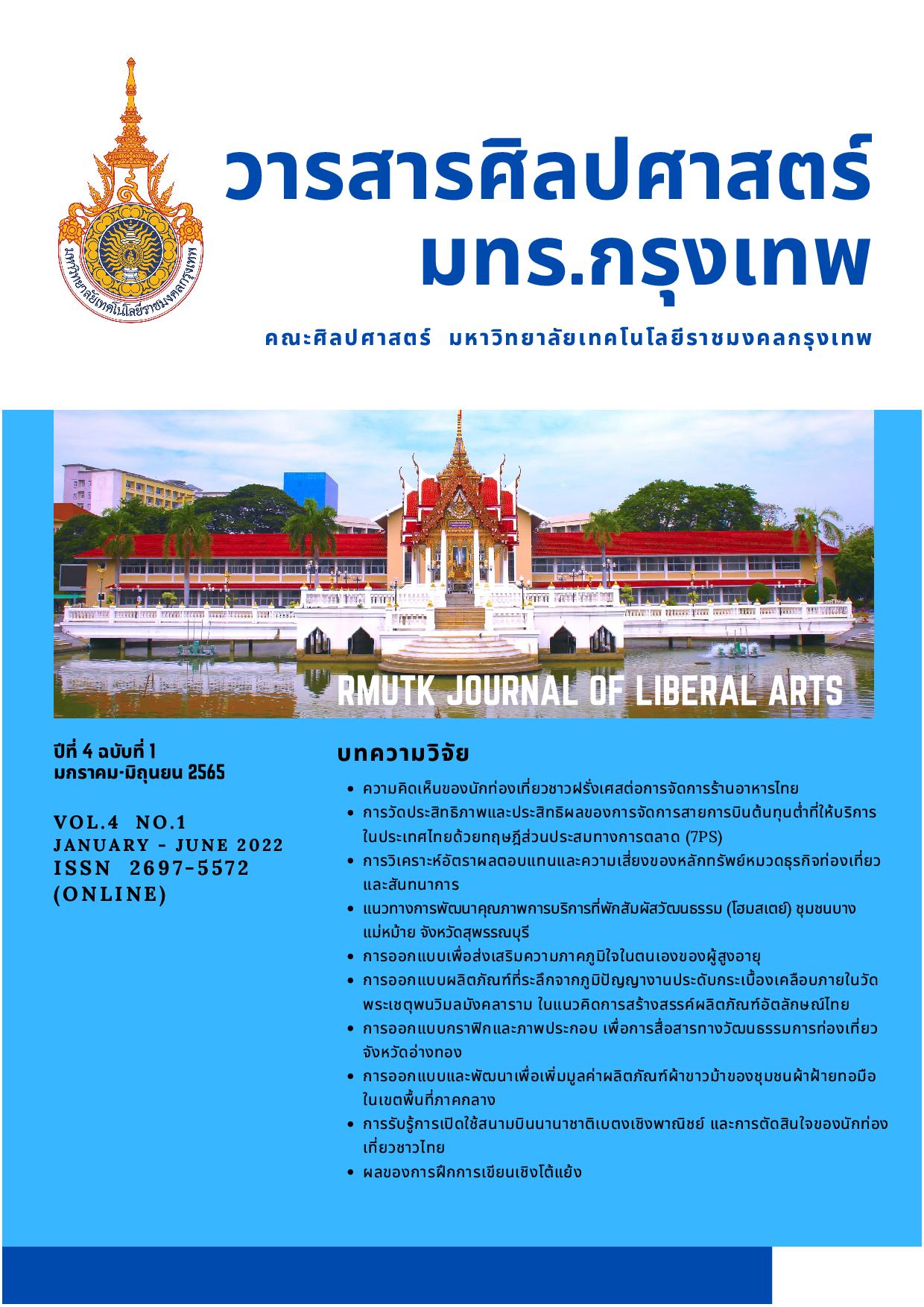การออกแบบผลิตภัณฑ์ที่ระลึกจากภูมิปัญญางานประดับกระเบื้องเคลือบภายในวัดพระเชตุพนวิมลมังคลาราม ในแนวคิดการสร้างสรรค์ผลิตภัณฑ์อัตลักษณ์ไทย
Main Article Content
บทคัดย่อ
การศึกษาวิจัยครั้งนี้มีวัตถุประสงค์เพื่อศึกษาอัตลักษณ์ไทย ของภูมิปัญญางานประดับกระเบื้องเคลือบภายในวัดพระเชตุพนวิมลมังคลาราม โดยการศึกษาความต้องการนักท่องเที่ยว และเพื่อออกแบบผลิตภัณฑ์ที่ระลึก ในแนวคิดการสร้างสรรค์ผลิตภัณฑ์อัตลักษณ์ไทย โดยใช้ระเบียบวิธีวิจัยเชิงคุณภาพและปริมาณ โดยมีการศึกษาตามวัตถุประสงค์ คือ 1.เพื่อศึกษารูปแบบภูมิปัญญางานประดับกระเบื้องเคลือบภายในวัดพระเชตุพนวิมลมังคลาราม 2.เพื่อศึกษาปัจจัยและความต้องการของนักท่องเที่ยว วัดพระเซตุพนวิมลมังคลาราม 3.เพื่อออกแบบผลิตภัณฑ์ที่ระลึก วัดพระเชตุพนวิมลมังคลาราม ประชากรและกลุ่มตัวอย่างตามวัตถุประสงข้อที่ 1 ประซากร และ กลุ่มตัวอย่าง คือ ผู้ทรงคุณวุฒิและ ผู้เชี่ยวซาญ ด้านประวัติศาสตร์ศิลป์และ โบราณคดีของพื้นที่ศึกษา เลือกกลุ่มตัวอย่างโดยใช้วิธีการเลือกแบบเจาะจง เครื่องมือที่ใช้ ได้แก่ แบบสัมภาษณ์ เป็นการสัมภาษณ์ แบบไม่มีโครงสร้าง วัตถุประสงค์ข้อที่ 2 ประชากร และ กลุ่มตัวอย่าง คือ นักท่องเที่ยวที่มาท่องเที่ยวในพื้นที่เป้าหมาย เลือกกลุ่มตัวอย่างโดยใช้วิธีการเลือกแบบโควต้า เครื่องมือ ได้แก่ แบบสอบถามข้อมูล เพื่อเป็นแนวทางการศึกษาความต้องการของผลิตภัณฑ์ที่ระลึก วัดพระเชตุพนวิมลมังคลาราม วัตถุประสงค์ข้อที่ 3 ประซากรและกลุ่มตัวอย่าง คือ ผู้ทรงคุณวุฒิและ ผู้เชี่ยวชาญ ด้านการออกแบบผลิตภัณฑ์ การเลือกกลุ่มตัวอย่างโดยวิธีการเลือกแบบเจาะจง เครื่องมือ ได้แก่ แบบตรวจสอบรายการ และ แบบสอบถามแบบปลายเปิด เพื่อขอความคิดเห็น ตามวัตถุประสงค์เพื่อขอคำแนะนำ การวิเคราะห์ข้อมูล ค่าเฉลี่ยและ ค่าเบี่ยงเบนมาตรฐาน ผลการวิจัยพบว่ารูปแบบผลิตภัณฑ์ที่ระลึกที่ 1 มีระดับความเหมาะสมในระดับดีมาก (=4.55, SD=0.48) ซึ่งถือได้ว่ามีความเหมาะสมที่จะนำมาใช้เป็นรูปแบบสำหรับการพัฒนาเป็นผลิตภัณฑ์ที่ระลึก วัดพระเชตุพนวิมลมังคลาราม
Article Details

อนุญาตภายใต้เงื่อนไข Creative Commons Attribution-NonCommercial-NoDerivatives 4.0 International License.
เอกสารอ้างอิง
กฤษณะ เดชาสุรักษ์ซน. (2552). พฤติกรรมและทัศนคติของนักท่องเที่ยวอิสระชาวต่างชาติที่มีต่อวัดพระเซตุพนวิมลมังคลาราม ราชวรมหาวิหาร กรุงเทพมหานคร. (สารนิพนธ์ปริญญาบริหารุรกิจมหาบัณฑิต ไม่ได้ตีพิมพ์). มหาวิทยาลัยศรีนครินทรวิโรฒ, กรุงเทพฯ.
การท่องเที่ยวแห่งประเทศไทย. (2561). รายงานสถานการณ์และผลประกอบการอุตสาหกรรมการท่องเที่ยว . กรุงเทพฯ.
อนุกรรมาธิการด้านศิลปะและวัฒนธรรม. (2561). รายงานโครงการมรดกความทรงจำแห่งโลกวัดพระเชตุพนวิมลมังคลารามราชวรมหาวิหารวิมลมังคลาราม. กรุงเทพฯ: คณะกรรมการการศาสนา ศิลปะ วัฒนธรรมและการท่องเที่ยว สภานิติบัญญัติแห่งชาติ.
พัชราพรรณ เสงี่ยมศักดิ์. (2560). ความต้องการซื้อผลิตภัณฑ์เชิงสร้างสรรค์จากภูมิปัญญาของไทย. อุบลราชธานี:มหาวิทยาลัยอุบลราชธานี
พระมหาศุภวัฒน์ ฐานวุฑโฒ, และนพวรรณ วิเศษสินธุ์. (2562). การจัดการแหล่งเรียนรู้ทางประวัติศาสตร์ ของวัดพระเชตุพนวิมลมังคลารม เพื่อรองรับประเทสไทย 4.0. วารสารพุทธศาสนาศึกษา, 10(1), 149-165.
วันเพ็ญ เบอร์เนทท์. (2549). ปัจจัยที่มีผลต่อความพึงพอใจโดยรวมจากการท่องเที่ยวของนักท่องเที่ยวต่างชาติที่มาเที่ยวในวัดพระเชตุพนวิมลมังคลาราม (วัดโพธิ์) (สารนิพนธ์ปริญญาบริหารธุรกิจมหาบัณฑิต ไม่ได้ตีพิมพ์). กรุงเทพฯ: มหาวิทยาลัยศรีนครินทรวิโรฒ.
สุชาติ อิ่มสำราญ, พรเทพ เลิศเทวศิริ, และ อินทิรา พรมพันธุ์. (2564). การออกแบบผลิตภัณฑ์ของที่ระลึกจากอัตลักษณ์ศิลปะพื้นบ้านสำหรับนักท่องเที่ยว. วารสารวิชาการ คณะสถาปัตยกรรมศาสตร์ สจล., 33(23), 115-129.
สุรศักดิ์ ใจหาญ. (2559). การศึกษาและออกแบบผลิตภัณฑ์เพื่อการประชาสัมพันธ์วัดไชโยวรวิหาร อำเภอไชโย จังหวัดอ่างทอง. วารสารศิลปกรรมศาสตร์ มหาวิทยาลัยขอนแก่น, 8(2), 341-355.
อภิญญา เฟื่องฟูสกุล. (2546). อัตลักษณ์ = Identity : การทบทวนทฤษฎีและกรอบแนวคิด. กรุงเทพฯ: คณะกรรมการสภาวิจัยแห่งชาติ สาขาสังคมวิทยา สำนักงานคณะกรรมการวิจัยแห่งชาติ.


